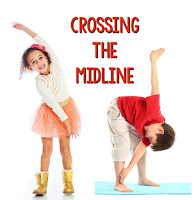Have you been thinking about your child's midline crossing troubles? Have you noticed any problems with bilateral skills in your child? Then definitely some of our questions must been storming your mind? So here we are with answers.....
What is crossing the body’s mid-line?

Why is crossing the body’s mid-line important and what are the effects on children who don not cross the body's midline?
Crossing the midline of body is required for the appropriate development of various skills.
When a child spontaneously crosses the mid-line with the dominant hand, then the dominant hand gets the practice needed to develop good fine motor skills by repeated consistent hand dominance.
If a child avoids crossing the mid-line, then both hands tend to get equal practice at developing skills and the child’s true handedness may be delayed.
Children who have difficulty crossing midline may appear ambidextrous because they are often observed using both hands, but they actually have a hidden neuroprocessing issue. Both sides of their brains are not communicating, resulting in decreased coordination, decreased motor control of movements and difficulties achieving higher level skills. Often, these children end up with two unskilled hands
Difficulty crossing the mid-line also makes it difficult to visually track a moving object from one side to the other or track from left to right when reading, meaning reading can also be delayed.
While the child is moving his/her eyes from left to right across the page, the eyes will stop at midline to blink and refocus; however, when this happens, the child will very frequently lose his/her place on the line and become confused as to where they left off.
It also affects handwriting, as diagonal lines cross the midline, and the child may need to stop in the middle of the page to switch hands when writing from left to right. Many self care and daily living skills require crossing midline, example, perfecting the skill of putting socks or shoes on requires one hand to cross over to the other side of the body.
How can we say child has problems with crossing their body’s mid-line?
If a child has
difficulties crossing the body mid-line they might:
These children generally have difficulty
coordinating gross motor patterns (e.g. crawling, skipping, star-jumps) and can’t participate in sports that require
good coordination (e.g. Basketball, baseball, netball, tennis). As it is expected for this age group that most self care skills are independent or requiring only minimal assistance, the child suffers from increased pressure and anxiety in a school age.
We pause here, but we shall be back with more on this next week....
We will continue to update you more on bilateral skills and midline crossing disorders and bring to you more information on:
We pause here, but we shall be back with more on this next week....
We will continue to update you more on bilateral skills and midline crossing disorders and bring to you more information on:
1.What other problems can occur when a child has crossing the body’s mid-line difficulties?
2.Do you know what activities can help improve crossing the body’s mid-line?
3.Why do we need therapy if child feels difficulties in crossing the body’s mid-line?
4.If left untreated what can difficulties crossing the body’s mid-line lead to?
Please follow our blog and feel free contact us and visit on our website www.healthymomshome.com
Contact details:whatsapp number: 9755700579,9453443603(no calls accepted, only whatsapp messaging )
Email: nootan.nayana724@gmail.com
geet.tyagi7@gmail.com
Website: www.healthymomshome.com








No comments:
Post a Comment